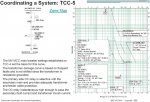SKM and some other publications recommend selecting the CT ratio on the primary side of a transformer to be 200% of transformer FLA base rating and to set the 51 pickup at 110-140% of FLA. I have a pdf of IEEE Industry Applications Society that also recommends CT ratio to be 200% of transformer FLA and <300% of transformer self cooled rating or 150% of transformer max rating.
IEEE C37.110 says the maximum design load current should not exceed the CT rated primary current.
Ignore being under the transformer damage curve and to the right of the inrush. I am only inquiring about the relay setting compared to the CT ratio.
The IEEE Industry Applications Society pdf shows examples of time-current curves and the trip settings are beyond the CT ratio primary value. I have attached two examples from the pdf that show long time settings of 2.5 and 2.73 times the CT primary value.
My questions are: Is this common? Are there any issues to look out for when selecting a trip setting that is 2-3 times the CT rated primary current?
I would think if the CT is designed to handle 20 times rated current and still be within 10% error, it has no problem handling 2-3 times the CT rating for the 51 setting, but I'd like to hear from those who have more experience in this area than I. Maybe SKM is being overly conservative in their recommendation?


IEEE C37.110 says the maximum design load current should not exceed the CT rated primary current.
Ignore being under the transformer damage curve and to the right of the inrush. I am only inquiring about the relay setting compared to the CT ratio.
The IEEE Industry Applications Society pdf shows examples of time-current curves and the trip settings are beyond the CT ratio primary value. I have attached two examples from the pdf that show long time settings of 2.5 and 2.73 times the CT primary value.
My questions are: Is this common? Are there any issues to look out for when selecting a trip setting that is 2-3 times the CT rated primary current?
I would think if the CT is designed to handle 20 times rated current and still be within 10% error, it has no problem handling 2-3 times the CT rating for the 51 setting, but I'd like to hear from those who have more experience in this area than I. Maybe SKM is being overly conservative in their recommendation?


Last edited:
